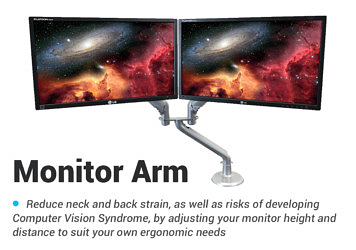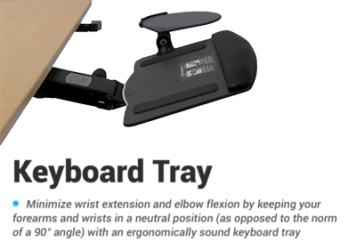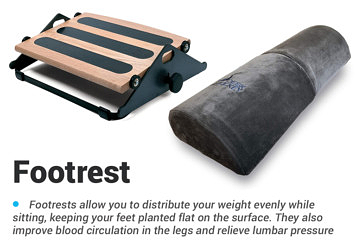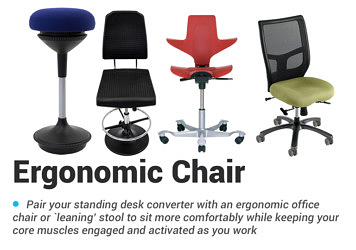Autonomous SmartDesk Pro Standing Desk Review
- Lab tested
Like most reviews sites, our editorial staff and laboratory testing expenses are partially offset by earning small commissions (at no cost to you) when you purchase something through those links. Learn More

Overview
| Review Summary |
The Autonomous SmartDesk Pro is an upgraded, dual-segment entrant to its line with specs that look impressive on the surface. However, stability is still a concern, a wide height range won’t accommodate short users and there’s a lack of attention to detail all around. Plus, this desk is not cheap. Autonomous has revamped their website, changed the names of many of their desks and increased prices in an effort to change their reputation. The SmartDesk Pro is definitely an improvement, but it still falls behind the competition. |
|---|---|
| MSRP / List Price | $649 |
| Street Price |
43″ x 24″: $649 |
| Shipping |
Free |
| Warranty |
7 years on frame, 1 year on top |
| Lift Type |
Electric dual-motor, dual-stage legs |
| Transit Speed |
1.3 ips |
| Controller |
Digital with four programmable height presets |
| Sizes Available |
53″ x 29″, 70″ x 30″ |
| Colors Available |
53″ x 29″: White, black, walnut, white oak, bamboo, dark bamboo, five different printed designs |
| Adjustment Range |
Height range: 26.2″-52″ |
| Weight Capacity |
310 lbs |
| Typical Assembly Time |
45-60 min |
| NEAT™ Certified by Mayo Clinic |
No |
| Competition |
Compare to All Top-Rated Standing Desks
|
| Where to buy |
Buy on Autonomous Buy on Amazon |
Rating
| Ease of Assembly | |
|---|---|
| Stability | |
| Reliability | |
| Customer Experience | |
| Innovation | |
| Value | |
| Positives | The SmartDesk Pro can be aesthetically pleasing with its variety of color options in the medium size. The weight capacity is very solid. |
| Negatives | It won’t fit short users. It’s unstable. The desktop design was poorly stretched to fit a desktop size it wasn’t designed for. Assembly is as much of a pain as any Autonomous desk has ever been — labor is definitely shifted to the consumer to keep these desks as cheap as possible. Desktop size and color selections are very limited. The whole desk has a low-quality feel, like other Autonomous desks, despite the “Pro” designation. |
Bottom Line
Autonomous has gone through great pains to reinvent itself lately. With a new website and new desk names (the problematic SmartDesk 2 was re-branded to the SmartDesk Core, which we’ve also reviewed), the company has tried to move past the low quality and poor customer reviews that plagued it not so long ago.
These desks, especially this SmartDesk Pro we review below, do have better specs, but it comes at a significant bump up in cost as Autonomous desks are no longer the cheapest brand you can buy.
How Does The SmartDesk Pro Differ From The SmartDesk Core?
The biggest difference you get when you upgrade to the SmartDesk Pro is a dual-stage frame (three-segment lifting columns) and higher voltage power supply. This results in a bump in weight capacity, from 265 pounds to 310 pounds, and an improved height range of 25.2”-51”.
The height range is especially important. One of our biggest gripes with the SmartDesk Core was the height range. It was limited (as all single-stage frames are) but specifically limited in a way that left out short and medium height users.

The SmartDesk Pro’s minimum height of 26.2” is still on the taller side for a dual-stage frame and will therefore not fit very short users well. In fact, it’s still 4” shy of the minimum height requirement for ANSI/BIFMA certification for use in some corporate, government and educational institutions.
The counterpoint of that is a tall maximum height of 52” compared to most ANSI/BIFMA certified desks that top out at about 48”, or maybe 50”. This, in theory, makes the Autonomous SmartDesk Pro a good option for treadmill-desk users (although it still lacks 6” leg extender options like on iMovR standing desks, that you’d really want if you were planning to use and under-desk office treadmill).
The reason that theory doesn’t translate to reality, however, is that the SmartDesk Pro becomes very unstable at or near its maximum height.

This kind of stability issue was easier to look past when it was on a very cheap dual-stage electric desk. But, with the raised prices we mentioned above, this is no longer a cheap desk. The cheapest configuration is $649 (with a 43″ x 24″ top), then the medium (with a 53” x 29” top) will cost $699, while the XL (with a 70.5” x 30” top) comes in at $999.
Similar to the SmartDesk Core, the product page for the SmartDesk Pro product page says it does not have an anti-collision feature, but it actually does. It engages inconsistently and isn’t sensitive enough to truly rely upon, but it is there. Testing it right next to the SmartDesk Core, the system in the Pro was not as good because it was more difficult to trigger, especially when descending. There is no anti-tilt feature, which is something that’s more expected to be included in new standing-desk designs these days —particularly those, like this one, that are being marketed as Work-From-Home products — and certainly those in this price range.

The controller on the SmartDesk Pro has four memory presets, which is pretty standard these days, but no Bluetooth connectivity. Bluetooth-sync’d smartphone apps for standing-desk users are becoming more and more popular, and indeed even Autonomous has one for their higher-end desk that we’re reviewing as part of a new roundup we’re working on (be sure to subscribe to our free newsletter to learn more), but the Pro desk will never be able to work with that app.
Desktop Options
The desktop is not the standard high-pressure laminated (HPL) desktop that most cheap standing desks come with. Instead, it’s just a plain MDF board that has been slightly ergo-contoured around the rim with a ¼” radius, and then powder-coated (spray painted). This is actually even cheaper to make than HPL, but gets rid of the hard edges when you lean your arms against the desk or bump your hip into a corner. (Learn more about the different materials and technologies used in making desktops for standing desks.)
Powder-coated MDF is one of the cheapest types of desktops to manufacture, if not the cheapest, but is highly susceptible to damage because it adds little or no protection from scratches, dents, or cleaning chemicals. Spill your Coke on it and the paint might just come off if you don’t wipe it up quickly enough.

The powder-coated top comes with a one-year warranty. Frankly, most Chinese-made desktops don’t even have a warranty at all, but even those that do usually have so many exclusions that the only thing they’ll really replace is a board damaged in shipping. If you spill your coffee and it stains through the paint, that’s on you.
While there are some American powder-coated MDF desktops that are much more durable (and come with 10-year warranties, like on the ZipDesk), the performance of the Autonomous powder coat paint is very typical of, if perhaps a little better than most Chinese-manufactured powder-coated tops.
The desk does come with quality grommet covers that have cable pass-throughs. We have seen previous reviewers say the grommet covers don’t hold in the grommets well and can pop out annoyingly when cables move through them, but we didn’t see that issue at all so maybe they’ve updated the grommet hole diameter to hold the grommet caps in place a bit better.
As mentioned above, there are three desktop sizes available, 43″ x 24″, 53” x 30”, and 70.5” x 30”. The 53” x 29” desktop comes in 9 different “colors”: white, black, walnut, white oak, bamboo, dark bamboo, pink, blue, and teal. The small desktop only comes in white, while the XL comes in black, white, or walnut.
Autonomous offered the Artists X Autonomous collection, which is no longer listed on their website the last time we looked. This group of 12 desktop designs came from small artists who actually get a percentage of every sale. This option was very cool and added an entirely new dimension of customization to your desk. It certainly showed up in the price, though. A medium sized SmartDesk Pro with an Artists X Autonomous top came in at $999. The XL Artists X Autonomous would cost up to $1,399.

As fun as the Artists X Autonomous designs were, we did find a couple of small issues. First, the ink from the design is slightly raised. It’s very slight and likely won’t bother most people, but there’s a chance it could bother you if you write a lot on single sheets of paper (as opposed to writing on a notepad). Second, the design appears to have been made for one desktop size and stretched to fit another. As you can see in the photo to the right, there are black, nearly grommet-hole-sized circles near the grommet holes. This is the same with both grommet holes.
If you look at this same desktop design on the Autonomous website below, the circles line up with the grommet holes much better.
Similar to the slight raising of the ink, this likely won’t bother many people, but might drive others crazy once they notice it.
Assembly Struggles
Assembly for the Autonomous SmartDesk Pro can be a bit of a maze and that’s reflected in the very first step of the installation (see our video of the SmartDesk Core installation, which is the same process as the SmartDesk Pro). In that first step, you’re instructed to loosen the support beam and “adjust Beam to proper position to fit the Desk Top” but there’s no indication of what that proper position is because the instructions were written for all desktop sizes. Going from comments on the Autonomous assembly video, many users were tripped up by this step.
The workaround is to not adjust the beam until you reach step six and place the assembled desk frame onto the desktop. You’ll then have to slide it and line it up with the pre-drilled holes in the desktop. This isn’t difficult, but it does show a lack of attention to detail that has always been problematic with Autonomous’ assembly guides. Not to get too snarky about it, but it seems like Autonomous has always taken the same attitude about standing desk assembly as IKEA does, that figuring out their obfuscating instructions should be part of the fun.

Another issue is in step two, where you attach the legs to the support beam. The instructions show the support beam on the ground and the leg being dropped into place from above. This method doesn’t actually work because of how the cutouts for the cables line up. The leg must be placed on the ground and the support beam placed over it. Just like the above example, this workaround isn’t overly difficult, but it’s mildly annoying that you have to figure it out.
There are also problems with the pre-drilled holes where the support beam attaches to the desktop because two of the pre-drilled holes do not line up with the rubber stoppers. This is another known issue, again because of comments on the Autonomous assembly video. Autonomous responded to many of the comments saying not to worry about it and use the holes that line up. This worked for us and provided a stable connection, but you should be wary that this is technically improper assembly and may give Autonomous an out if you ever needed to exercise your warranty.
Finally, the instructions do not contain information about setting the height memory presets. To do this, you put the desk at the height you’d like, hold down the “M” button until the height flashes, and then push the preset number you’d like to set.
If the above issues are all addressed, this assembly would rate as medium/hard among standing desks. There are 44 bolts and screws to install, but at least there were no issues with bolts turning into painted threads as we’ve seen with some desks, like UpLift’s V2. The screws were difficult to get in by hand, so we definitely recommend using a cordless screwdriver. Expect to take more than an hour without an electric drill and just under an hour with one.
Warranty
The warranty is seven years on the frame and one year on the desktop. This is a step up from the SmartDesk Core’s warranty (five years on frame, one year on desktop), but still well behind other big players like UpLift, Fully and iMovR who have up to 15-year warranties on their desks. The industry norm in this price range is now at least 10 years. (For more information on warranties, be sure to read our primer on How to Compare Warranties on Standing Desks, as some of them can be fraught with so many carve-outs as to be highly diminished when it comes time to actually get any service.)
And as we noted above in the assembly section, this installation has parts that are difficult and may require a workaround, which could theoretically actually void your warranty, so you definitely wouldn’t want to let your SmartDesk Pro sit around more than a month before assembling it.
Autonomous does offer free returns within 30 days. To avoid a potential 30 percent restocking fee, you need to hold onto your original packaging for 30 days, or until you’re sure you won’t be returning the desk.
The Takeaway

The upgrade from the Autonomous SmartDesk Core to the SmartDesk Pro mostly involves the upgrade from a single-stage base to a dual-stage base. This brings a slightly higher weight capacity and improved height adjustment range. Speaking of that height adjustment range, it’s clearly designed around taller users and short users may not be able to use it as well at sitting height (though the workaround for this may be to install an under-desk keyboard tray).
The Artists X desktops are a really cool idea but they, unfortunately, suffered from an apparent lack of attention to detail and weren’t resized correctly for all desktop sizes. That overall lack of attention to detail (it’s also very present when it comes to assembly), is really the reason we are lukewarm on this Autonomous desk even though it’s an improvement from previous models the company has produced in the past.
Some of these issues were easier to overlook when Autonomous desks were super cheap, but that’s no longer the case. A 70” SmartDesk Pro is $999 in its cheapest configuration, which means it’s tussling with a whole different field of competitors. Nowadays, there’s an army of fly-by-night Chinese sellers on Amazon offering cheap standing desks for under $250, so if you’re looking for super cheap standing desks, go there (and prepare to buy a new one every year).
With its brand shift to a polished American-style website and pricing that’s clearly aimed squarely at the major commodity import brands in the US (Fully, Uplift, Flexispot) and even the bottom end of premium American brand iMovR, Autonomous doesn’t appear to really have shed any of its core Chinese-made product quality issues to warrant paying these new prices.
Check out our full roundup of standing desks to see where the SmartDesk Pro ranks among others we’ve reviewed. Plus, visit the complete Autonomous brand roundup for more information on their complete offerings.
Many standing desks and converters come with grommets for some added convenience. Check out our article on grommet holes for everything you need to know about the different ways to use them to enhance your workstation, what to look for in your grommet holes, and where to find the desks with the best ones.






0 Comments
Leave a response >